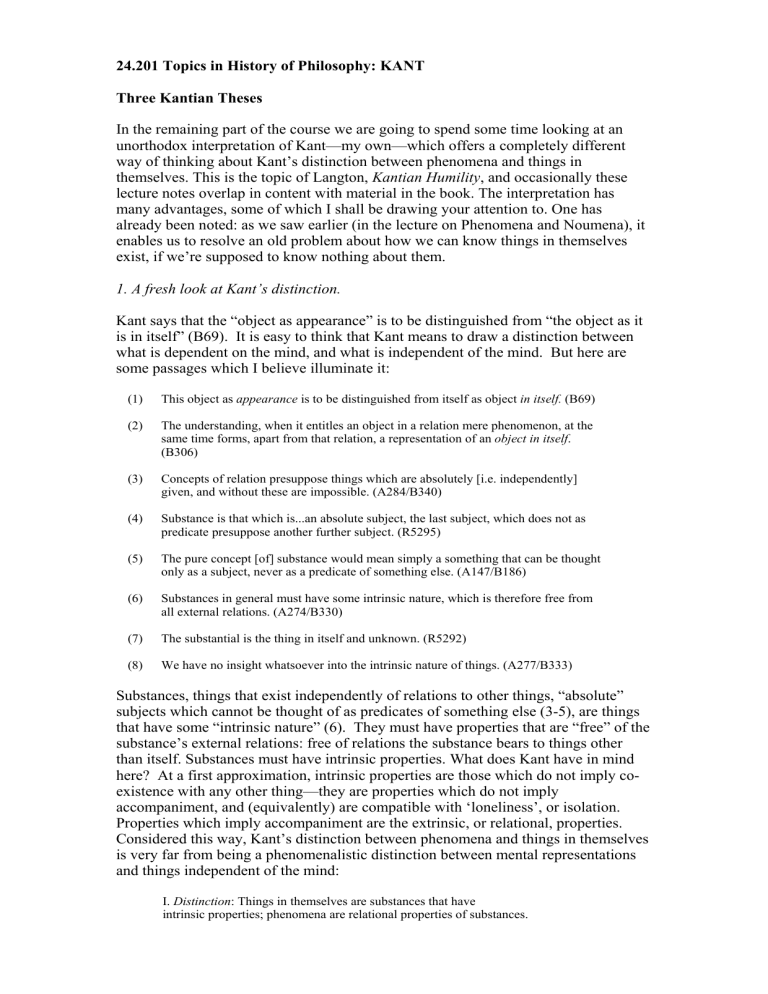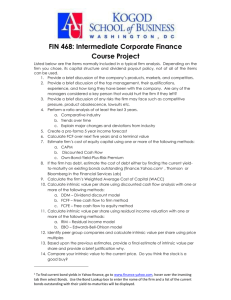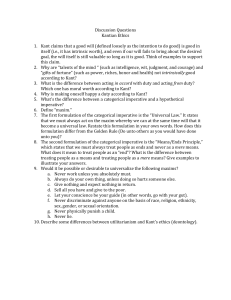24.201 Topics in History of Philosophy: KANT Three Kantian Theses

24.201 Topics in History of Philosophy: KANT
Three Kantian Theses
In the remaining part of the course we are going to spend some time looking at an unorthodox interpretation of Kant—my own—which offers a completely different way of thinking about Kant’s distinction between phenomena and things in themselves. This is the topic of Langton, Kantian Humility , and occasionally these lecture notes overlap in content with material in the book. The interpretation has many advantages, some of which I shall be drawing your attention to. One has already been noted: as we saw earlier (in the lecture on Phenomena and Noumena), it enables us to resolve an old problem about how we can know things in themselves exist, if we’re supposed to know nothing about them.
1. A fresh look at Kant’s distinction.
Kant says that the “object as appearance” is to be distinguished from “the object as it is in itself” (B69). It is easy to think that Kant means to draw a distinction between what is dependent on the mind, and what is independent of the mind. But here are some passages which I believe illuminate it:
(1) This object as appearance is to be distinguished from itself as object in itself.
(B69)
(2) The understanding, when it entitles an object in a relation mere phenomenon, at the same time forms, apart from that relation, a representation of an object in itself .
(B306)
(3) Concepts of relation presuppose things which are absolutely [i.e. independently] given, and without these are impossible. (A284/B340)
(4) Substance is that which is...an absolute subject, the last subject, which does not as predicate presuppose another further subject. (R5295)
(5) The pure concept [of] substance would mean simply a something that can be thought only as a subject, never as a predicate of something else. (A147/B186)
(6) Substances in general must have some intrinsic nature, which is therefore free from all external relations. (A274/B330)
(7) The substantial is the thing in itself and unknown. (R5292)
(8) We have no insight whatsoever into the intrinsic nature of things. (A277/B333)
Substances, things that exist independently of relations to other things, “absolute” subjects which cannot be thought of as predicates of something else (3-5), are things that have some “intrinsic nature” (6). They must have properties that are “free” of the substance’s external relations: free of relations the substance bears to things other than itself. Substances must have intrinsic properties. What does Kant have in mind here? At a first approximation, intrinsic properties are those which do not imply coexistence with any other thing—they are properties which do not imply accompaniment, and (equivalently) are compatible with ‘loneliness’, or isolation.
Properties which imply accompaniment are the extrinsic, or relational, properties.
Considered this way, Kant’s distinction between phenomena and things in themselves is very far from being a phenomenalistic distinction between mental representations and things independent of the mind:
I.
Distinction : Things in themselves are substances that have intrinsic properties; phenomena are relational properties of substances.
2. Ignorance.
Kant says “the substantial is the thing in itself and unknown” (7); and
“we have no insight whatsoever into the intrinsic nature of things” (8). Kant thinks we have no knowledge of things as they are in themselves. But here that does not express idealism, but something else—the second of my three Kantian theses:
II.
Humility :We have no knowledge of the intrinsic properties of substances.
The two theses—Distinction and Humility—are the basis for our earlier argument about how to save Kant from the old problem, encountered in our lecture on
Phenomena and Noumena.
2. The inference to things in themselves.
We can see why Kant thinks it would be absurd to deny the existence of things in themselves. One often finds in Kant an argument that the very notion of an appearance—an objective appearance, a phenomenon—implies the existence of a thing in itself:
Although we cannot know these objects [i.e. objects of experience] as things in themselves, we are required to be able to think of them as things in themselves.
Otherwise we should have the absurd conclusion that there could be appearance without there being something that appears. (Bxxvi)
Now we should bear in mind that the concept of appearance...itself establishes the objective reality of noumena, and justifies the division of objects into phenomena and noumena, and indeed in such a way that the distinction does not refer simply to the logical form of our knowledge...but to the way in which they are themselves generically (der Gattung nach) distinct from each other. For if the senses represent to us something merely as it appears, this something must also be a thing in itself. (A249)
It follows naturally from the concept of an appearance in general that something which is not itself appearance must correspond to it. For an appearance can be nothing on its own...Unless we are to move in an endless circle, the word
“appearance” must already indicate a relation to something...which, however, must be something in itself. (A251-2)
In regarding objects of the senses merely as appearances, we thereby acknowledge that a thing in itself underlies them, although we have no knowledge of how it is in itself...Thus, through the very admission of appearances, the intellect acknowledges the existence of things in themselves as well; and we can say that to this extent the thought of such beings underlying the appearances is not only permissible, but unavoidable. ( Prolegomena §32)
These passages make no sense on a phenomenalistic interpretation, i.e. on an interpretation according to which phenomena are mental states, representations, or sensations. What could be easier, after all, than to suppose that there could be representations without something that exists apart from our states of mind? But if an appearance is a phenomenon, an object in a relation (B307), and if concepts of relation presuppose something that exists in itself, independently of the relation
(A284/B340), then appearance does presuppose something that exists in itself, independently of the relation that is involved in appearance. We have here a particular application of the more general principle. As a general rule, relations, and relational properties, imply the existence of independent bearers: i.e. substances whose existence is independent of other things, with properties whose existence is independent of other things.
3. The source of ignorance.
Kant seems to believe that our ignorance of things as they are in themselves follows directly from the fact that we have knowledge only in so far as things are given to the senses .
Properties that belong to things as they are in themselves can never be given to us through the senses. (A36/B52)
What is at stake in this notion of the senses?
To say that knowledge of things depends on the senses is to say that it depends on our being affected by things.
(Human) intuition...is always sensible, that is...affected by objects (A35/B51)
The receptivity of our mind, its power of receiving representations in so far as it is affected in any way, is called “sensibility”.... Our nature is such that our intuition can never be other than sensible, that is, it contains only the way in which we are affected by objects. (A51/B75)
Here we come to the empiricist strand in Kant’s thinking, the third Kantian thesis:
III. Receptivity . Human knowledge depends on sensibility, and sensibility is receptive: we can have knowledge of an object only in so far as it affects us.
Kant believes that our ignorance of the intrinsic properties of things follows from the fact that knowledge depends on our being affected by things: he thinks that Humility follows from Receptivity. Why? We’ll come to that in a moment.
4. Some more textual evidence.
(9) The and Extrinsic .—In an object of the pure understanding the intrinsic is only that which has no relation whatsoever (so far as its existence is concerned) to anything different from itself. It is quite otherwise with a substantia phaenomenon in space; its intrinsic properties are nothing but relations, and it itself is entirely made up of mere relations. We are acquainted with substance in space only through forces which are active in this and that space, either drawing other objects
(attraction) or preventing their penetration (repulsion and impenetrability). We are not acquainted with any other properties constituting the concept of the substance which appears in space and which we call matter. As object of pure understanding, on the other hand, every substance must have intrinsic properties and powers which concern its inner reality. (A 265/B321)
(10) Substances in general must have some intrinsic nature, which is therefore free from all external relations....But what is intrinsic to the state of a substance cannot consist in place, shape, contact, or motion (these determinations being all external relations).
(A274/B330) is . I search for that which belongs to it intrinsically in all parts of the space which it occupies, and in all the actions it performs, and these of course can only be appearances to external sense. So I have nothing that is absolutely intrinsic, but only what is comparatively intrinsic, and that is itself again constituted by external relations. It is silly to suppose that matter has an absolute intrinsic nature of the sort conceived by pure understanding, for matter is not an object of pure understanding. On the other hand, the transcendental object which may be the ground of this appearance that we call matter is a mere something. We would not understand what it was, even if someone could tell us...If the complaints that “we have no insight whatsoever into the intrinsic nature of things” are supposed to mean that we cannot grasp by pure understanding what the things which appear to us may be in themselves, they are completely unreasonable and stupid. They want us to be able to be acquainted with things without senses! (A277/B333 ff.)
(12) All that we know in matter is merely relations (what we call its intrinsic properties are intrinsic only in a comparative sense), but among these relations some are...enduring, and through these we are given a determinate object...It is certainly startling to hear that a thing is to be taken as consisting wholly of relations. Such a thing is, however, mere appearance. (A285/B341)
(13) Everything in our knowledge which belongs to intuition...contains nothing but mere relations, of locations in an intuition (extension), of change of location (motion) and of laws according to which this change is determined (moving forces). What presents itself in this or that location, or, beyond this change of location, what activities occur within the things themselves, is not given through these relations.
Now through mere relations one cannot be acquainted with a thing as it is in itself.
We may therefore conclude that since external sense gives us nothing but representations of mere relations, this sense can contain in its representation only the relation of an object upon the subject, and not the intrinsic properties that belong to the object as it is in itself. (B67)
(i) Phenomena as relational . In (9) Kant draws a distinction between the intrinsic and extrinsic, or relational; he claims phenomenal substance “consists wholly of relations” (12), (11), (9), (13). He refers in (9) to the “intrinsic properties” of matter, but says what we call its intrinsic properties are only ‘comparatively’ intrinsic; matter couldn’t have an absolutely intrinsic nature (11 and 12). Two kinds of properties, spatial and dynamical (9), (13).
(ii) The ‘in itself’ as the intrinsic.
What presents itself as matter in space is not given through the relations (13); Kant is talking about two aspects of the one thing: the thing that presents itself to us as matter is the same as the thing that has “activities” occurring within it, “intrinsic properties belonging to the object as it is in itself”, see also (11, 9) . Note a different reading of ‘ external appearance ’: we’re acquainted with the extrinsic (‘external’), but not the intrinsic, properties of substances.
(iii) Spatial properties as relational.
Kant seems to believe that spatial properties, even apparently intrinsic properties such as shape, are extrinsic, or relational, because they depend on the parts of the shaped body.
Corporeal things are never anything but relations only, at least of their parts external to one another. (A339/A283)
This suggests that Kant’s understanding of intrinsicness is to be interpreted in a particular way. We began with the idea that an intrinsic property is a property something can have even when unaccompanied by another distinct thing: what counts as another distinct thing? A proper part of a thing is not identical with the whole: so it is, in one sense, a distinct thing. If spatial properties of an extended object depend on the parts, and if a part is a distinct thing for the purposes of Kant’s notion of intrinsicness, that would make spatial properties extrinsic properties.
(iv) Forces as relational.
Dynamical properties are relational for different reasons. In explaining why they are “mere relations”, Kant says forces “are active in this or that space, either drawing other objects (attraction) or preventing their penetration
(repulsion and impenetrability)” (A265/B321). Is force a relation, e.g. the relation a thing bears to another when a thing attracts another? Or is it a causal power to enter into such relations, e.g. the power a thing has to attract another? Kant seems to think of forces as both. He thinks of them as relations (of attraction and repulsion), and as causal powers (of attraction and repulsion), and either way, as relational properties.
But are they? Something can have a power to attract without actually attracting, so the power is not to be identified with the relation itself. All the same, there is something relational, something other-directed, about the concept of a force, construed as a power, something conceptually relational about a force. (Does that prove that force, is, as Kant thinks, an extrinsic property? No. The relationality of concepts is not the same as the extrinsicness of properties: but we’ll postpone that.)
5. A new problem for Humility .
In the above passages Kant denies knowledge of things in themselves by saying that we have no knowledge of the intrinsic properties of substances: (9), (11), (13).
Properties that belong to things as they are in themselves can never be given to us through the senses. (A36/B52)
It is not that through sensibility we are acquainted in a merely confused way with the nature of things as they are in themselves; we are not acquainted with that nature in any way at all. (A44/B62)
He suggests here (and in 11) that Humility follows from Receptivity. Kant clearly thinks that there is something about his empiricist starting point, something about the senses , that prevents us from having knowledge of the intrinsic natures of things.
Why? Strawson is keenly aware of the importance of this question, or his version of it, and he says that Kant never offers an answer. According to Kant, says Strawson, knowledge through perception of things...as they are in themselves is impossible. For the only perceptions which could yield us any knowledge at all of such things must be the outcome of our being affected by those things; and for this reason such knowledge can be knowledge only of those things as they appear...and not of those things as they...are in themselves. The above is a fundamental and unargued complex premise of the Critique .
i
In this remark Strawson draws attention to a fundamental unanswered question in
Kant’s philosophy. Kant’s inference, as it stands, presents a problem. Humility does not follow from Receptivity: or not, at any rate, without some other premise. But what could that be? i
P.F. Strawson, Bounds of Sense, p. 250.


